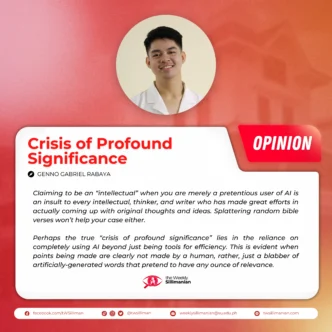By Dan Angello Rafael Degamo
Across the Philippines, hospital hallways overflow with patients from across the island, who have traveled for hours, only to find out that there are too few hands to care for them.
As much as nurses want to cater and serve everyone fairly, they can only do so much. Every day, our nurses stretch themselves toward the breaking point, leading many to make the difficult decision to leave the profession, sometimes en masse, for nursing opportunities abroad.
Inside our hospitals, a staggering imbalance. Nurse-to-patient ratios often stretch to 1:20, when the Department of Health (DOH) itself sets the safe standard at 1:12. In some cases, it climbs as high as 1:50.
Our nurses pull exhausting double shifts, monitoring and scrambling from patient to patient, all while carrying the knowledge that one missed step can cost or harm a precious life. And while such demands rise, the compensation barely scratches the surface of what is owed for such unforgiving work.
By 2025, the DOH estimates a shortage of around 127,000 nurses nationwide—part of a wider 190,000 health worker gap. Despite nearly 990,000 registered nurses in the country, only about 617,000 are actively practicing, showing just how many have shifted away from local service or left for work abroad.
The bigger picture paints a truth that’s hard to swallow.
Closed wards, long lines, and a population that is struggling—all left to make do with far less care than they deserve. Hospitals feel this absence every day. Some have the beds, the buildings, and the machines, but not the nurses.
One of the country’s largest hospital networks has built capacity for around 3,800 beds, yet can only operate between 2,500 and 3,000 of them due to the shortage of nurses. Emergency rooms, sadly, delay admissions not because patients are few but because wards have no staff to take them in. Infrastructure without people is just concrete.
A 2023 report also revealed that between 200,000 and 250,000 Filipino nurses have left the profession altogether—worn down by low pay, burnout, and precarious working conditions.
Abroad, the pull is very irresistible and undeniable: better pay, safer ratios, chances for growth, and a sense of security. Against that backdrop, the decision to leave stops being a matter of loyalty and becomes a matter of survival.
We train thousands, yet fail to keep them. The “exodus” should not be seen as abandonment of the nation and their fellow countrymen, but as a loud indictment of a system that has failed to honor their work.
To keep our nurses, we must match their courage with commitment: fair wages, safe ratios, and a path for growth at home. Because every nurse who stays is not just saving lives—they are saving the very heart of our nation’s healthcare system.












